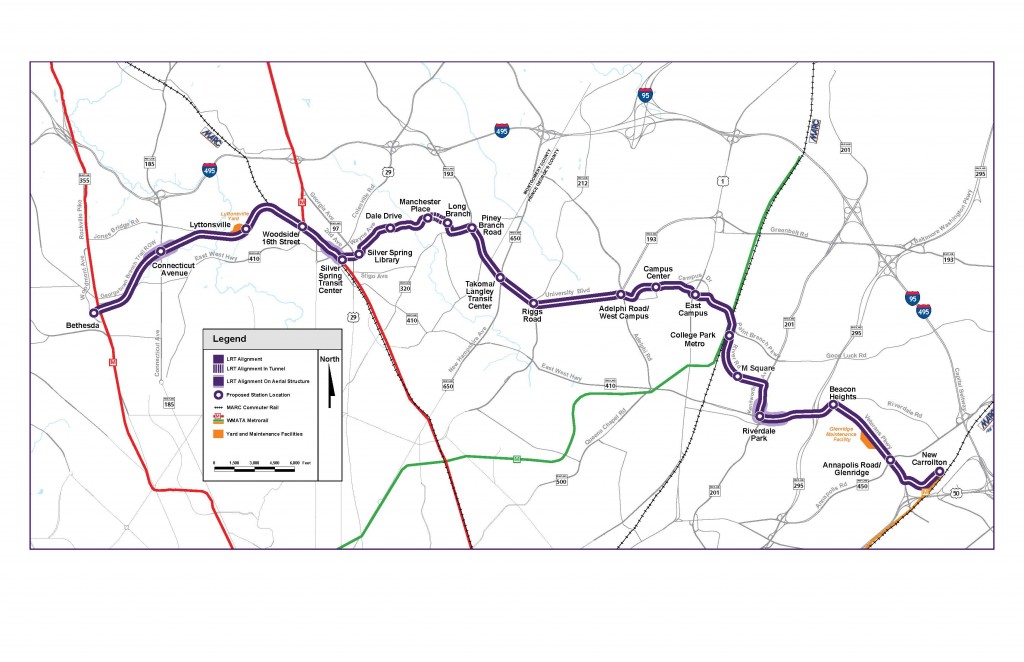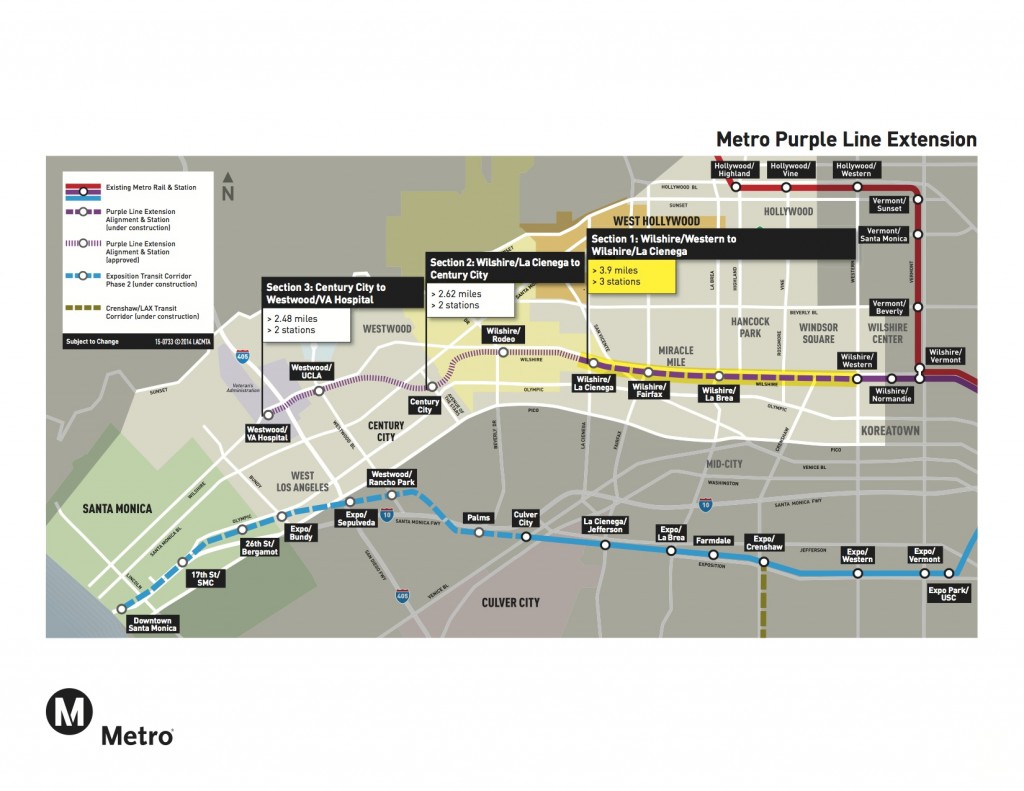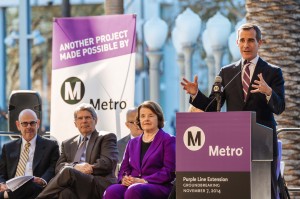No, not the L.A. purple line subway down Wilshire. It’s the Maryland light rail purple line, providing a critical rail connection between spokes of the beleaguered Washington DC Metro. Think of it as the rubber tire connecting the end of the Metro spokes, per this map:
 Last year, I triumphantly blogged that the rail line was approved after the Republican governor of Maryland had a change of heart from his highway-favoring ways. I took credit because I had just given a talk on rail in Washington DC (victory has a thousand parents).
Last year, I triumphantly blogged that the rail line was approved after the Republican governor of Maryland had a change of heart from his highway-favoring ways. I took credit because I had just given a talk on rail in Washington DC (victory has a thousand parents).
But this year, a judge has put the kibosh on the line, due to a lawsuit by affluent homeowners upset at losing the current leafy bikeway and trail to a rail line for the masses. As Construction Dive reported, the gist of the decision is that new environmental analysis is now required to revise the ridership estimates. It seems that falling DC Metro ridership, which purple line backers relied on for their analysis, need to be taken into account to revise the projections downward.
The decision is jeopardizing $900 million in federal funds already committed, and it may kill the project entirely if the new numbers don’t pencil well. As a backup, the rail line could turn into a busway, but it would be a major setback for transit advocates.
It’s another example that contentious rail projects and litigation are not just a feature of California’s politics, and that the usual suspects of affluent homeowners groups hold sway across the country when it comes to these critical infrastructure projects.
Because it definitely had nothing to do with my presentation.
 It’s huge news for the Maryland suburbs of Washington DC. The Purple Line is a light rail connector filling in the spokes of the heavy-rail Metro system and connecting two major dense suburban centers. The project was suddenly in doubt when Larry Hogan was elected governor last November, a surprise win for a conservative in an overwhelmingly liberal state. Hogan had campaigned against the wasteful spending of the project and has made more money for automobile infrastructure a priority.
It’s huge news for the Maryland suburbs of Washington DC. The Purple Line is a light rail connector filling in the spokes of the heavy-rail Metro system and connecting two major dense suburban centers. The project was suddenly in doubt when Larry Hogan was elected governor last November, a surprise win for a conservative in an overwhelmingly liberal state. Hogan had campaigned against the wasteful spending of the project and has made more money for automobile infrastructure a priority.
But Hogan’s transportation secretary came out in favor of the project, and the federal transit agency had already pledged support. The governor is still flashing his conservative bona fides by requiring cost cutting on the project and more county contributions. He also wants the private contractors who build it to step up with financial support. Overall, those positions could be very helpful for the economics of the project.
Here’s more detail:
The line would still have 21 stations and run from Bethesda in Montgomery to New Carrollton in Prince George’s. It would pass through Silver Spring and the University of Maryland’s College Park campus. The Purple Line will connect to Amtrak and MARC commuter rail stations and will be the first rail line to directly connect spokes of a Metrorail system designed decades ago to carry commuters between the suburbs and downtown Washington.
Hogan also was influenced by Washington-area politicians and business leaders, who said the project was crucial to improving transit and encouraging growth inside the Beltway.
“The Purple Line is a long-term investment that will be an important economic driver for Maryland,” Hogan said. After expressing skepticism in the past about what he saw as overblown forecasts of how many jobs the project would create, he said construction alone would create 23,000 jobs in Maryland over the next six years.
And hey, I’m not claiming credit, but Tuesday night I give a presentation for Washington DC Purple Line advocates on LA’s Metro Rail history, and on Thursday the conservative new governor approves the line. You make the call.
 Well, that only took 30 years. Groundbreaking for the badly needed Wilshire Purple Line subway extension happened this morning. The new extension will run from the current terminus at Western along Wilshire Boulevard to La Cienega, with stops at La Break and Fairfax in between. I can’t overstate how important this project is for mobility in Los Angeles. It will serve as the transit backbone for the Westside and will provide a mobility option for the most densely populated corridor west of the Mississippi River.
Well, that only took 30 years. Groundbreaking for the badly needed Wilshire Purple Line subway extension happened this morning. The new extension will run from the current terminus at Western along Wilshire Boulevard to La Cienega, with stops at La Break and Fairfax in between. I can’t overstate how important this project is for mobility in Los Angeles. It will serve as the transit backbone for the Westside and will provide a mobility option for the most densely populated corridor west of the Mississippi River.
Of course, if Congressman Waxman hadn’t stopped the line back in the mid-1980s, the ceremony would be occurring today on Wilshire and Fairfax instead, and we’d be looking at an extension now into Century City. But oh well, no point in looking back. (Or we could just look at the photo of Waxman sitting next to the podium, celebrating an event that he tried to stop and then succeeded in delaying for decades.)
But in the meantime, this new 3.9-mile extension isn’t slated to open for almost a decade, in 2023. And these projects have a way of falling behind schedule. This after voters essentially approved the funding six years ago in 2008 with the passage of Measure R. So the delays involved are mind-boggling.
This timeline must be shortened. I hope rail advocates and elected officials step up the pressure to get this project completed in a few years and not decades. There’s simply no reason in this modern age why a 3.9-mile tunnel should take that long. We should have a thorough, transparent explanation for the construction timeline and a plan for how to overcome the challenges. Angelenos should know what they can do to move this project along.
So while there is a lot to celebrate today, there’s more work to be done to make sure this project gets built quickly, inexpensively, and in a manner that maintains the public’s trust.



